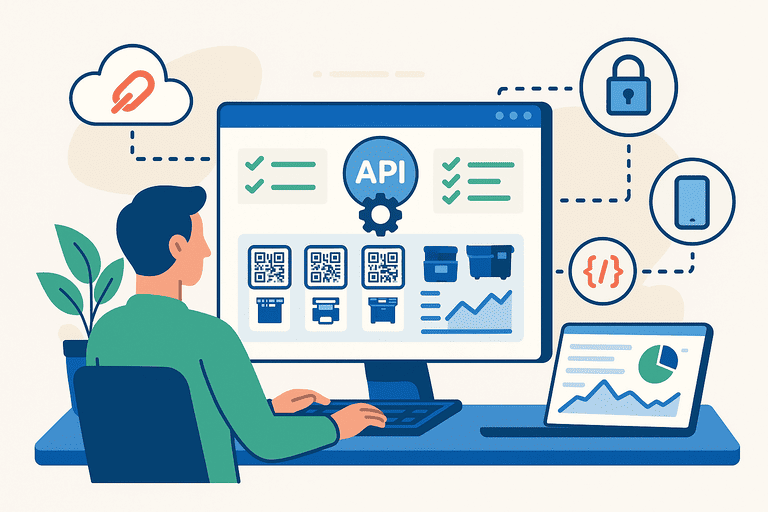The Role of APIs in Modern Inventory Systems
Discover how APIs enhance inventory systems by enabling integrations, real-time updates, and automated data synchronization across platforms.

Introduction
In the past, inventory systems operated as isolated tools — useful but limited. Today, businesses need systems that talk to each other: accounting software, HR databases, e-commerce stores, and logistics platforms.
That’s where APIs (Application Programming Interfaces) come in.
APIs act as the digital connectors between systems, allowing them to share data seamlessly.
For inventory management, APIs enable real-time asset tracking, automated updates, and integrations that reduce manual effort and eliminate silos.
This article explores how APIs power modern inventory systems — and why they’re essential for scalability, efficiency, and data accuracy.
1. What Is an API, in Simple Terms?
An API allows one software system to communicate with another using predefined rules.
Think of it as a translator — it enables two different platforms to share data and trigger actions without human involvement.
For example:
- Your inventory platform can send stock level updates to accounting software.
- An HR system can automatically assign laptops when new employees are onboarded.
- A maintenance app can receive service logs after each equipment check.
In short, APIs connect data and automate workflows that were once manual.
2. Why APIs Matter for Inventory Systems
Modern inventory management isn’t just about counting assets — it’s about visibility and automation.
APIs make this possible by connecting your inventory data with every system that depends on it.
Key advantages:
- Real-time updates: Prevent duplication and outdated information.
- Reduced manual input: No need to copy-paste between tools.
- Improved accuracy: One source of truth for all systems.
- Custom integrations: Tailor your workflows for specific use cases.
- Scalability: Add new tools without reworking your entire tech stack.
Whether you’re managing ten devices or ten thousand, APIs make it possible to scale without chaos.
3. Common Use Cases for Inventory APIs
1. HR and Employee Management
Automatically assign or revoke assets when employees join or leave the company.
APIs sync employee records between HR software and inventory systems.
2. Accounting and ERP
Connect to platforms like QuickBooks or Xero for:
- Automatic depreciation tracking
- Expense categorization
- Capital asset reconciliation
3. Maintenance Management
Send maintenance schedules and receive service logs directly from IoT-enabled devices or maintenance platforms.
4. E-Commerce and Retail
Sync product stock levels and shipping status in real time between warehouses, point-of-sale systems, and online stores.
5. Communication Tools
Push notifications to Slack or Teams when assets are checked out, overdue, or require service.
APIs turn inventory data into live information accessible across all business operations.
4. API Architecture in Modern Inventory Systems
Most modern systems use RESTful APIs (Representational State Transfer) — a flexible, widely supported architecture.
Typical REST API components:
| Component | Example | Description |
|---|---|---|
| Endpoint | /api/assets | Path to access asset data |
| Method | GET, POST, PATCH, DELETE | Defines action type |
| Authentication | API key or OAuth token | Secures access |
| Response format | JSON | Machine-readable data |
For example:
GET /api/assets?status=active
{
"results": [
{ "id": "123", "name": "Laptop Dell", "location": "Berlin Office" },
{ "id": "124", "name": "Projector Epson", "location": "Paris Office" }
]
}
This kind of interface lets developers pull, update, or delete asset data programmatically — enabling everything from automation scripts to full integrations.
5. Security and Access Control
Because APIs connect critical business systems, security is non-negotiable.
Best practices include:
- Use API keys or OAuth 2.0 for authentication.
- Apply role-based access to limit what integrations can modify.
- Use HTTPS for all data exchange.
- Enable rate limiting to prevent abuse.
- Log every API request for audit trails.
Security design ensures APIs empower your operations — not expose them.
6. Real-World Example Workflows
Workflow 1: Automated Employee Device Assignment HR system creates a new user profile.
- API triggers a call to inventory system → assigns default devices.
- Notification sent to IT with asset details.
Workflow 2: Maintenance Escalation IoT sensor detects machine error.
- API posts alert to maintenance platform.
- Inventory updates item status to “Under Maintenance.”
Workflow 3: Finance Reconciliation Inventory system sends depreciation data monthly.
- Accounting software updates balance sheet automatically.
- These examples show how APIs eliminate friction and human dependency.
7. Future Trends in Inventory APIs
Emerging trends are pushing inventory APIs beyond simple integration:
- GraphQL APIs for flexible data queries.
- Webhooks for instant real-time updates (push notifications).
- IoT integrations for smart assets that update themselves.
- Cross-system AI analytics that predict maintenance or utilization needs.
As systems become more interconnected, APIs form the nervous system of business operations.
Conclusion
In a world where software ecosystems define efficiency, APIs make inventory systems adaptive and future-proof. They eliminate silos, ensure data consistency, and connect every part of your business — HR, finance, logistics, and operations — in real time.
APIs aren’t just technical features; they’re the bridge that transforms inventory management from static to dynamic.
Explore more integrations and automation-focused articles: